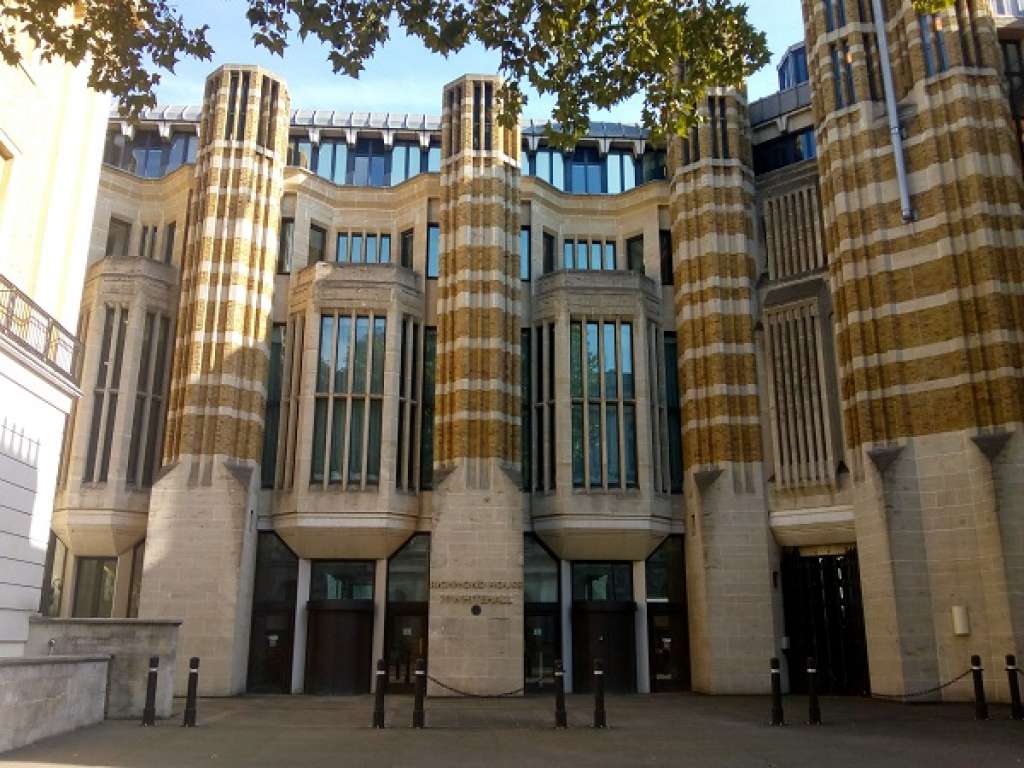Press release: SAVE backs alternative Hopkins proposal for temporary House of Commons in bid to rescue grade II* listed Whitehall landmark

Grade II* listed Richmond House on Whitehall
15 October 2018
SAVE is backing an alternative proposal by renowned architect Sir Michael Hopkins for the temporary House of Commons chamber, required by the £6bn refurbishment of the Palace of Westminster. The alternative proposal would reprieve the grade II* listed Richmond House on Whitehall - currently slated as the government's preferred site for the temporary chamber and threatened with major demolition and redevelopment. See the article published in The Times today.
Drawing by Michael Hopkins, showing the temporary Chamber within Portcullis House
Designed by Sir William Whitfield and his partner Andrew Lockwood, Richmond House opened in 1988 to critical acclaim. Initially the proposal was to place the temporary chamber in the courtyard of the Whitfield building which (in theory) could have been reinstated when the refurbishment of the house of Parliament is complete. However proposals now under consideration involve the complete loss of the Whitfield building except for the Whitehall frontage.
The alternative plans, drawn up by Sir Michael Hopkins, show how the dimensions of the existing House of Commons chamber could be accommodated within the large atrium of Portcullis House, the Stirling Prize nominated office building for MPs opposite Big Ben. It was designed by Hopkins and opened in 2001. Though not yet developed in detail, the proposal demonstrates there is space for the Ayes and Noes lobbies on either side of the chamber all set within the atrium.
The temporary chamber would only occupy half the internal space of the atrium leaving the other half free for its present use – meeting space and cafés for MPs and visitors etc. The temporary diminution of atrium space for MPs would be counterbalanced by major time and cost savings – integrating the chamber into the Portcullis House atrium would cost less than virtually rebuilding Richmond House. Just 30 years after it was completed, its redevelopment is also not justified in terms of sustainability and embodied energy. Richmond House could be sensitively adapted to provide ample office space for MPs.
Richmond House
Writing in Country Life in 1988 Roderick Gradidge a leading critic of contemporary architecture wrote Whitfield is “one of the most distinguished architects of his generation…” He continued “There has been no staircase as grand as this in a Whitehall Office since Scott built his intentionally overpowering staircase in the Foreign Office”.
Whitfield’s Richmond House, incorporates the handsome Regency Richmond Terrace, designed in 1819 by Thomas Chawner, and built in 1822-4. The official listing description of 2015 sets out the quality and importance of Whitfield’s work citing the “high quality interiors.... Richmond House has a notable, monumental succession of principal internal spaces, unparalleled at the time in purpose-built post-war government offices”. All these could be swept away in the proposed rebuilding of Richmond House as offices for MPs.
As completed in 1988 Richmond House provided, according to the magazine Building, “15,000 square metres [150,000 sq ft] of all-purpose government offices to house some 450 bureaucrats”. Whitfield’s new buildings back on to New Scotland Yard a handsome red brick building designed by Richard Norman Shaw, one of the most original and acclaimed of late 19thcentury architects. Whitfield’s staircase towers echoed Shaw’s distinctive palette of materials in a modern idiom – hefty grey granite bases and red brickwork banded with grey granite.
Marcus Binney, Executive President of SAVE Britain's Heritage, says “William Whitfield is one of the most distinguished architects of modern times, producing beautiful, original and thoughtful buildings. He is sensitive to context, working beside cathedrals including St Paul's and Canterbury. His work at Richmond House is the best new building in Whitehall since the war [Portcullis House is on the Thames], with fine interiors, beautiful craftsmanship and a superb succession of spaces. Here he took inspiration from the Houses of Parliament, Henry VII's Chapel and Richard Norman Shaw's much admired New Scotland Yard. Surrounded by some of the best architecture in London he rose magnificently to the challenge. Demolition of the major part of Richmond House would be state-sponsored vandalism of the first order.
We urge MPs to look seriously at the Hopkins alternative in the interests of avoiding the destruction of Sir William Whitfield’s superb building. Since the World War II a major battle has had to be fought to save practically every landmark building in Whitehall including the Foreign Office and the Treasury. ”
Henrietta Billings, Director of SAVE Britain's Heritage, says: The Hopkins drawings show that that trashing our modern architectural heritage to make way for a temporary chamber does not have to be inevitable. The potential environmental and cost savings from adapting Portcullis House, and re-opening Richmond House for office space rather than almost wholesale demolition and rebuilding are huge - surely its in all of our interests that these options are fully explored."
SAVE urges MPs to consider the Hopkins alternative which potentially offers major savings in both time and cost. If the new temporary Commons chamber is built within Richmond House this is likely to require a new high-security entrance. This could be in the form of a new security blockhouse on the Whitehall pavement in front of the Richmond House main entrance. This would form a major eyesore in front of the Cenotaph, the nation’s principal war memorial. By contrast a temporary Commons chamber in the atrium of Portcullis House would be within the existing security cordon.
Ends.
Note to editors
1. For more information please contact SAVE on 020 7253 3500 or office@savebritainsheritage.org
